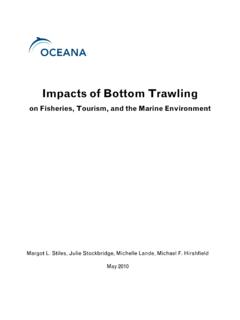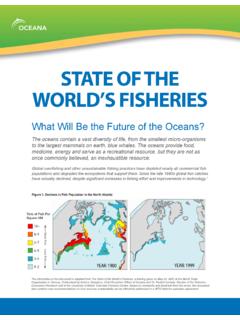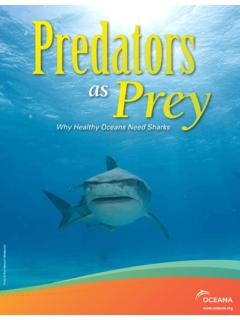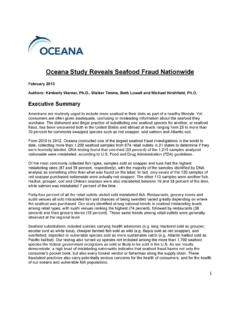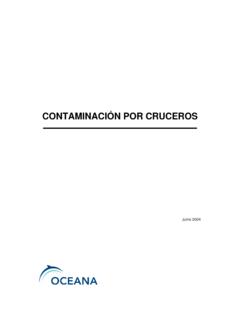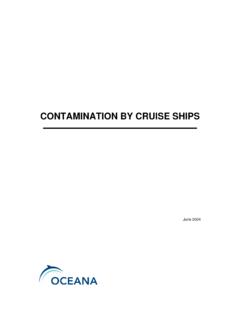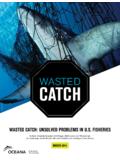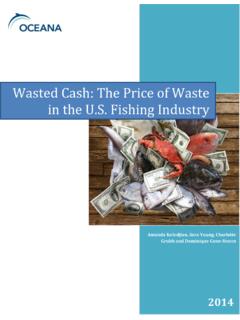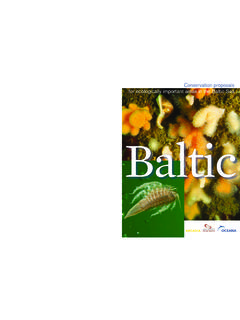Transcription of WHYHEALTHYOCEANSNEEDSEATURTLES - oceana.org
1 PHOTO TIM CALVER. WHY HEALTHY OCEANS NEED SEA TURTLES: THE IMPORTANCE OF SEA TURTLES TO MARINE ECOSYSTEMS. Wilson, , Miller, , Allison, D. and Magliocca, M. TURTLES. Acknowledgements The authors would like to thank Karen Bjorndal for her review of this report. We would also like to thank The Streisand Foundation for their support of Oceana's work to save sea turtles. PHOTO MICHAEL STUBBLEFIELD. OCEANA | Protecting the World's Oceans TABLE OF CONTENTS. WHY HEALTHY OCEANS NEED SEA TURTLES. 3 Executive Summary 4 Sea Turtles 5 Importance of Sea Turtles to Healthy Oceans 6 Maintaining Habitat Importance of Green Sea Turtles on Seagrass Beds Impact of Hawksbill Sea Turtles on Coral Reefs Benefit of Sea Turtles to Beach Dunes 9 Maintaining a Balanced Food Web Sea Turtles and Jellyfish Sea Turtles Provide Food for Fish 11 Nutrient Cycling Loggerheads Benefit Ocean Floor Ecosystems Sea Turtles Improve Nesting Beaches 12 Providing Habitat 14 The Risk of Ecological Extinction 15 Conclusions 1.
2 TURTLES. PHOTO TIM CALVER. 2 OCEANA | Protecting the World's Oceans EXECUTIVE SUMMARY. Sea turtles have played vital roles in maintaining the health of the world's oceans for more than 100 million years. These roles range from maintaining productive coral reef ecosystems to transporting essential nutrients from the oceans to beaches and coastal dunes. Major changes have occurred in the oceans because sea turtles have been virtually eliminated from many areas of the globe. Commercial fishing, loss of nesting habitat and climate change are among the human-caused threats pushing sea turtles towards extinction.
3 As sea turtle populations decline, so does their ability to fulfill vital functions in ocean ecosystems. Our oceans are unhealthy and under significant threat from overfishing, pollution and climate change. It is time for us to protect sea turtles and rebuild their populations to healthy levels as a vital step in ensuring healthy and resilient oceans for the future. PHOTO TIM CALVER. 3. TURTLES. SEA TURTLES. Seven species of sea turtles swim in the world's oceans: flatback (Natator depressus), green (Chelonia mydas), hawksbill (Eretmochelys imbricata), Kemp's ridley (Lepidochelys kempii), leatherback (Dermochelys coriacea), loggerhead (Caretta caretta) and olive ridley (Lepidochelys olivacea).
4 Every species except for the flatback inhabits waters and was listed as endangered or threatened under the Endangered Species Act (ESA) more than 30. years ago. Despite associated protection measures, no sea turtle species has recovered enough to be removed from the ESA and some populations continue to decline. Green Sea Turtles Hawksbill Sea Turtles Kemp's Ridley Sea Turtles ENDANGERED/THREATENED ENDANGERED ENDANGERED. Florida & Mexico Breeding Colony/All other areas PHOTO STEPHEN M. SCHELB PHOTO MICHELLE SCHARER PHOTO NPS. PHOTO SMITHSONIAN MUSEUM PHOTO GARY YOSS PHOTO KEDAR GORE.
5 Leatherback Sea Turtles Loggerhead Sea Turtles Olive Ridley Sea Turtles ENDANGERED THREATENED ENDANGERED/THREATENED. Mexico Breeding Colony/All other areas 4 OCEANA | Protecting the World's Oceans IMPORTANCE OF SEA TURTLES TO HEALTHY OCEANS. Humans have caused sea turtle populations to decline significantly all over the Initially, direct fishing for sea turtles was the main reason for population declines. Today, other threats, including injury or death in commercial fisheries, habitat degradation and climate change top the The resulting population Sea turtles even at diminished declines have reduced the species' ability to fulfill their roles in maintaining healthy marine population levels play an Because large sea turtle population declines occurred important role in ocean ecosystems.
6 Centuries ago, we lack a proper perspective or a reliable baseline against which to compare their current Due to the lack of historic information, some of the past ecological functions of sea turtles during periods of great abundance have certainly been Although we cannot now fully understand the roles sea turtles played centuries ago, it is important that we discover as much as possible. Better understanding of these roles will allow us to determine what structure and functions were lost in the ocean ecosystems, the environmental effects of remaining populations, and management and conservation measures required for sea turtles to reach historic levels and the improvements in ecosystem health that could result from restored sea turtle What we do know is that sea turtles even at diminished population levels play an important role in ocean ecosystems by maintaining healthy seagrass beds and coral reefs, providing key habitat for other marine life.
7 Helping to balance marine food webs and facilitating PHOTO TIM CALVER. nutrient cycling from water to land. 5. TURTLES. MAINTAINING HABITAT. Impact of Green Sea Turtles on Seagrass Beds Status: Green sea turtles, one of the Endangered few large species of herbivores that eat seagrass, help to maintain healthy seagrass beds. When green sea turtles graze, they increase the productivity and nutrient content of seagrass ,8 Without constant grazing, seagrass beds become overgrown and obstruct currents, shade the bottom, begin to decompose and provide suitable habitat for the growth of slime ,10 Older portions of seagrass beds tend to be overgrown with microorganisms, algae, invertebrates and Sea turtles forage on seagrass just a few centimeters from the bottom of the blades, allowing older, upper portions of the blades to float ,13 As the turtles crop and re-crop the same plot.
8 Seagrass blades are removed from the area rather than accumulating on the bottom. This results in a 15-fold decrease in the supply of nitrogen to seagrass roots, which impacts plant species, nutrient cycling, animal densities and predator-prey As seen in the Caribbean, the decline of green sea turtles can result in a loss of productivity in the food web including commercially exploited reef fish decreasing the amount of protein-rich food available for Florida Bay and the Gulf of Mexico are two excellent examples of the importance of green sea turtles on the health of seagrass beds.
9 The die-off of seagrass in these areas during the 1980s has been directly linked to the ecological extinction of PHOTO TIM CALVER. When green sea turtles graze, they increase the productivity and nutrient content of seagrass blades. 6 OCEANA | Protecting the World's Oceans Hawksbills allow other species, such as coral, to colonize and grow by removing sponges from reefs. PHOTO GARY YOSS. Impact of Hawksbill Sea Turtles on Coral Reefs PHOTO JUAN CARLOS CALVIN. Equipped with beak-like mouths, hawksbill sea turtles forage on a variety of marine sponges. By doing this, they change the species composition and distribution of sponges in coral reef Sponges compete aggressively for space with reef-building corals.
10 By removing sponges from reefs, hawksbills allow other species, such as coral, to colonize and ,19 Without hawksbills, sponges are likely to dominate reef communities, further limiting the growth of corals and modifying the very structure of coral reef The physical and chemical defenses of sponges they expose food to marine species typically unable prevent most fish and marine mammals from eating to penetrate the sponge's exterior, making sponges more As hawksbills rip sponges apart during feeding, vulnerable to ,23 Through their selective forag- ing behavior, hawksbills impact the overall diversity of reef PHOTO CARLOS SUAREZ.
